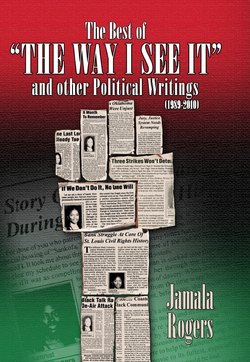Читать книгу The Best of "The Way I See It" and Other Political Writings (1989-2010) - Jamala Rogers - Страница 15
На сайте Литреса книга снята с продажи.
Black History Can be Found in Strange Places
ОглавлениеMarch, 1995
My people’s history can be found in strange and interesting places, particularly that history of Africans after they came to the shores of America. Joyce Potts is a sister who has a nose for important stuff. She spotted an old booklet at a popular flea market and bought it. Yellowed from age, the booklet is titled The Negro and subtitled Achievements of the Race.
For twenty five cents, you get the “essential information of the Negro.” On the cover is a photograph of George Washington Carver and there are bullet points of what is inside. The editor was Frederick W. Bond and it appears that other family members were also involved. Thomas J. Bond was the president and Anna Bond Johnson was the treasurer. The surprise for me was that the journal was printed right here in St. Louis by Midwest Mutual Publishing, located then at 4300 St. Ferdinand. St. Louis American’s Farley Wilson may even have a photo of these ambitious folks.
What was even more surprising was that the journal came out during World War II and gave insight into some of the issues of the day facing African Americans. The booklet was a compilation of reprints and information by famous black folks. One article titled, “Bill Would ‘Gag’ Biased Politicians” talks about a bill introduced by Senator Guy Gillette ((D-Iowa) to prevent political candidates in the 1944 Presidential race from appealing to the “racial and religious prejudice of voters.” Sounds familiar. Also known as the Gillette Propaganda Exposure Act, it required that all printed literature must state on the front the names of the people responsible for the writing, financing and publishing. It seems that anonymous racist campaign literature was flourishing and had to be put in check.
Several articles talked about the gallant role of blacks in the war and were quite critical of the status of blacks as second-class citizens at home. One raised the poignant question of “how about a little homegrown freedom for our own loyal American Negro? The American Negro was never known freedom from want; and he has also known fear at first hand…” There was internal debate among African Americans as to whether they should continue to push for justice and equality during the war or put all their collective energies into fighting WWII and then take back up their own struggles after the war. That debate raged throughout the war and was never settled.
Another article talked about how a large eastern war plant had hired 300 white women and no black women, despite the fact that 100 had been referred to the company. The explanation given by management was that the jobs required handling of small mechanics and blacks were rejected because they “all had ‘sweaty’ hands.”
An article by Frederick Douglass urged colored men to explore the skilled trades and new technology. Douglass warned blacks to “find new employments; new modes of usefulness to society or …decay.” While other articles talked about the “Negroid Stake in the 78th Congress” or how Southwestern Bell in Kansas City refused to sign a government contract agreeing to hire colored workers, or gave the inside story of the Detroit race riots, the most compelling article is “What the Negro Wants.” It challenged the continued denials of economic opportunities and political power to a sizeable portion of American’s population. The examples given of the conditions of blacks were all too familiar.
Unfortunately, not a whole lot has changed. The issues in the winter of 1943 - over 60 years ago - are still relevant today. The fight for freedom, justice and quality are alive and well. I thank those who came before me and wrote about our achievements (or lack thereof) so that we have a sense of history in order to better plan for the future.
“I hope that Americans as a whole will one day acknowledge the true of origin of this holiday, and remember the pain, loss, and agony of the Indigenous people who suffered at the hands of the so-called ‘pilgrims’…Let us face the truths of the past, and give thanks that we are learning to love one another for the rich human diversity we share.”
John Two-Hawks, The Thanksgiving Myth
